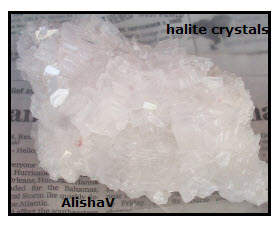CRYSTALS are solids with particles arranged in a regular, repeating pattern with flat surfaces.
Most solids are CRYSTALLINE SOLIDS, which are solids made of crystals. For example, when liquid water freezes, the water molecules link together forming ice crystals. A large piece of ice is made up of many small ice crystals that fit together like a puzzle. The shape of crystals depends on the arrangements of the particles within it.
A UNIT CELL is the smallest group of particles within a crystal that retains the geometric shape of the crystal. For example, the unit cell of a table salt crystal is cubic. For salt crystals to form, the cubic cells must be able to move about so that they can be positioned with their faces (flat surfaces) against one another.
Precipitates
PRECIPITATES are crystals that form when the solute (dissolved part) of a solution (mixture of a solute + a solute) precipitates. PRECIPITATION means that some of the solute falls out of the solution. Precipitation occurs when there is more solute than can dissolve in the solvent.
Different things can cause precipitation includin g, agitation and evaporation.
g, agitation and evaporation.
Evaporites
As the water evaporates from an aqueous (water) salt solution, the solution becomes more concentrated with salt; that is, as the amount of water decreases, there is more salt mixed with a smaller amount of water. Then there is more salt than can dissolve in the remaining water, the salt precipitates. As the salt (solute) precipitates its particles bond (link) together, forming unit cells that comprise a crystal. The more unit cells that bond together, the larger the crystal. Crystals that form due to evaporation, are called EVAPORITES.